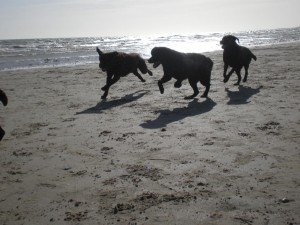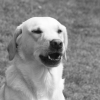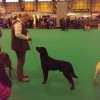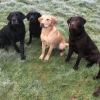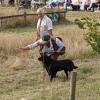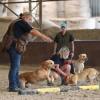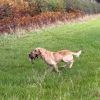Sensible Socialising –
(Subtitle: How not to raise an OVERsocial Labrador!)
Something that I’m very passionate about getting across to owners of the *vast majority* of well bred, socially raised dogs of our breed, is that the majority of dogs of this breed, raised by breeders who have bred from good natured parents, have handled the puppies a lot and showered them in love and attention, and who have had many visitors round to, again, cuddle and fuss them…. *tend* to leave with a huge amount of their canine and human socialisation already locked into their genes, and their minds.
By FAR, as a breeder and pet dog trainer, the biggest problem I see, in the response that most of these, well loved, well raised, well bred Labradors, have to seeing and meeting humans and other dogs, is that they believe ALL strangers and strange dogs were put on this earth to be run at or jumped on, and basically adored and played with… .
That is *delightful* in a 10 week old puppy. But this continues, and spirals, and is NOT delightful in a 10 MONTH old. It is fustrating, and often, embarassing.
MOST Labradors are literally ‘born’ ‘crazy in love’ with people and dogs……. but to a LOT of those people and dogs, there is no GOOD way, a 10 month old, that you only just met on a walk, covered in mud, CAN be ‘crazy in love’ with you.
Allowing your dog to become ‘people obsessed, attention obsessed and dog obsessed’, is a REAL danger. You don’t have to do MUCH of anything for it to start, increase, and then become your single biggest control and relationship problem.  🙁
🙁
I see socialising as having two themes:
1) Sights, sounds and situations. This is the whole going off down the high street as a babe in arms to see buses, and wheelchairs, and hear cars backfire, and doors slam. To maybe go in cars and learn about that. To go to the vets and see that vets are not always going to stick a big, fat, needle in your neck etc etc.
2) People and other canines.
This is the part that many people, totally inadvertantly, get VERY wrong in my opinion, and experience.
This is the part that many people, totally inadvertantly, get VERY wrong in my opinion, and experience.
Advice is given to have their pup meet people, and dogs, and learn about playing and running, and being cuddled and so on…. and with a 10 week old puppy, *almost* everyone will love him! They WILL want to give him a cuddle, pick him up. They will want to……. ‘let him have a play with Monty, he LOVES puppies……..’ So you do…… And yes, each and every time the puppy gets even bolder with other dogs, and people, and so, in a negative way, makes his ‘bounce rate’ for the odd bad experience he has meeting other dogs etc, probably HIGHER for the wide and varied constantly positive and manically happy experiences. But, hang on, you don’t WANT him not to learn from negative experiences, dismissing them amongst the million GOOD ones…. You want him to know that running off to other strange dogs on walks etc, COULD end very badly, and dogs are to be respected, given a wide berth to and not treated like some kind of toy!
A LOT of the problem is puppy training classes, vet puppy parties, ‘raising a puppy books’ etc etc are geared to ALL breeds. However OUR breed is different to so many. It was BORN social. It was BORN playing and understanding cuddles and love.
What the puppy actually needs to learn in the early days weeks and months is threefold:
1) That he/she is NOT always the center of attention, and definately NOT always part of everything we do.
2) YES other dogs and people exist in this world, On walks, to and from walks, and other public places…….. but they are NOTHING TO DO WITH YOU, YOUNG DOG!
3) That the owner will teach youngster about learning to use increasing amounts of self control, rather than strip you of it, inadvertantly, by making you believe that ‘all and sundry want you in their face’.
A balanced relationship:
Pretty much the single biggest problem I have in my Puppy, young dog and beginner classes, are that so many dogs do not have a balanced relationship with their owner.
Their owner loves them, and they love their owner. But they are not used to having to use self control under almost any circumstance, and almost never look to their OWNER for entertainment and reassurance, outside the home, they look to their owners HAND for food, and to the other dogs and people for entertainment….. or they look to the ENVIRONMENT for entertainment (hunting, sniffing, wildlife chasing etc).
So I’d like to explain how, maybe, whilst you can’t change up what is entirely cemented between an older dog’s ears, however that you *could* change how things are done with your next puppy.
How should you view walks?
I believe that walks should be times that are spent trying to grow the relationship between your DOG AND YOU….. Not with anyone else. Not with other strange dogs etc etc. Your dog is genetically hardwired to be social, and you can see that, every single day, from the desire to BE in the face of other dogs, even strange dogs, which is COMPLETELY not fitting with proper basic canine behaviour….. Throwing yourself at the mercy of strange dogs risks attack. This is a hardwired behaviour that owners ‘rub out’ by allowing the Puppy to play with ANY strange dogs, with ANY regularity.
(Note) Obviously at any point if your Labrador shows REAL fear of humans, or huge caution of other dogs, then you will relax these exercises and rules a little, and allow a bit more free interaction and positive experiences. That goes without saying. But only for the limited amount of time, and never forcing people or dogs in his/her face.
Barking, especially when on the lead at people and dogs, in 99% of cases is NOT fear, it is an excess of adrenaline, even if the dogs hackles are up. Its yelling ‘Come on! We could be having FUN! If only I could get off this damn pesky lead she has me on!! Party, Party PARTY!!!!’
Self control, the early days:
1) So… firstly. Self control. I strongly believe pups, from day one, SHOULD be let off the lead, in safe area, so it becomes ‘normal’. I also believe all dogs should have fairly regular runs daily in safe areas and this also should be *normal* (HOWEVER your pup OR adult does NOT need walking EVERY DAY…. they spend a life of luxury relaxing around their house and garden, this is ENOUGH…. Walks are just adding entertainment to an already happy carefree stimulating life. Don’t feel ANY compulsion to walk them publicaly every day. This just puts them into routines that you will regret if you find at some point walking is not possible (Seasons, illness, injury, your change of circumstances etc etc).
However there is a ‘turning point’ as regards ‘free runs’.
A puppy is full of natural insecurity so of course it will come back when called.
But the MINUTE you see that Puppy start to outgrow its natural insecurity, and start to think about not coming when called, or looking to respond, them changing its mind and ‘popping off elsewhere’ ….THIS is the time, to immediately see how the land is now starting to lie, and to start to reattach yourself to the youngster, as regards a longline or training lead. Attach anyway to SOMETHING that restricts its ability to FAIL and run up to people, dogs, wildlife… whatever is its ‘poison’. Failing is you losing. And you methodically teaching the dog it can tune you out with absolutely no consequences.
2)…..At Home – Visitors and no visitors:
Self control needs building at home. Visitors may come. But before you open the door pup is away. Crate. Another room. Behind a baby gate. Pup doesn’t just jump all over whoever is at the door! Again its sweet at 10 weeks, its HELL at 10 months!!!
Reschooling an older dog is not difficult. When someone comes to the house, then before the door is opened, the dog goes away.
YOU then interact with the visitor for a while.
THEN if they desire, the dog comes out to see them (and read that as pup too) ON A LEAD. You have control.
You don’t just take the oversocial dog straight up to visitor, you sit seperately for five minutes. Dog does NOT have to sit like a soldier but he’s not allowed immediate physical access to visitor. Then, maybe, you take dog on the lead, over to see visitor.
Your rules, and this makes you able to remove dog, immediately, if silliness and over adrenaline starts to happen.
Other useful stuff:
At home, it’s important to train your puppy to be put in its bed area, crate, or whatever sometimes…… EVEN THOUGH HUMANS ARE HOME. This is so so important! They must not believe they are part of everything, except for when you are out, or at bedtime. They actually need to learn that they may not be part of stuff EVEN WHEN you are around. This is priceless future stuff. PLEASE don’t be complacent on this.
Walks
Walks should be your private space, if possible, your bubble with you and your dog, to enjoy time with each other. They are NOT social times, unless VERY OCCASIONALLY, you actually arrange to meet someone. Even then, limit mad playing time, and do a little minute or two or controlled walking with both dogs on a lead, then another period of playing, then one on the lead with one off,… then change over which is on the lead…. The lead work doesn’t have to be perfect! Its just YOU taking CONTROL, and the dog not feeling from minute 1, to the end of the walk its a mad riot and a free for all.
Stranger’s dogs are NOT there to teach your pup a lesson, nor to exhaust your pup ‘so it sleeps’.
Please understand the failing of our gundog breeds are that they are play machines at 8 weeks old. Please use walks to politely, avoiding other dogs, by way of having your youngster on a longline so YOU can call the shots and all its free access to anything……
They do not need social skills enhanced, they need self CONTROL enhanced!!!!!
Enjoy your walks. Shout friendly greetings to other owners. Occasionally stand when their dogs run up to YOU and let them come and collect their naughty hound, as that they do if they tell you ‘their dog is friendly!’ or ‘Your pup will never learn to play if you don’t let it run with mine!’ or some such absolute nonsense.
IF all else fails, get used to telling people that your ‘youngster is an assistance dog in training, and therefore you are strictly told NOT to allow free play with strange dogs, or even nose to nose sniffing, as they need to learn to ignore other dogs!’. It’s a shame some people have to go to these lengths to have other people leave their pup/young dog alone, but it is, what it is! The whole ‘Run and play’ idea is so deep seated in some owners, it’s hard to persuade them otherwise, so don’t even TRY!
Avoid Failures:
Prevent failures by way of a nice suitable long line, and there are many on the market. Don’t allow MILES of it out, just ten yards or so, as you don’t want the dog able to gallop about, just trot about. YES your dog will pull and want more… but frankly, they go further than you want them to OFF lead, so you might as well just learn to deal with that. They will soon learn their boundaries if you bare with it. Be unpredictable on walks with your routes. Be unpredictable where you stand for five minutes and just view the vista! Where you march on Where you let the dog *off*, where you don’t, (even though you did yesterday)…. etc. Keep things interesting and varied.
Start young and you will programme them the right way. There is no upper age that you CAN’T at least TRY and reschool this. You just need to change things up and be happy take control back, on walks and at home.
Good luck 
